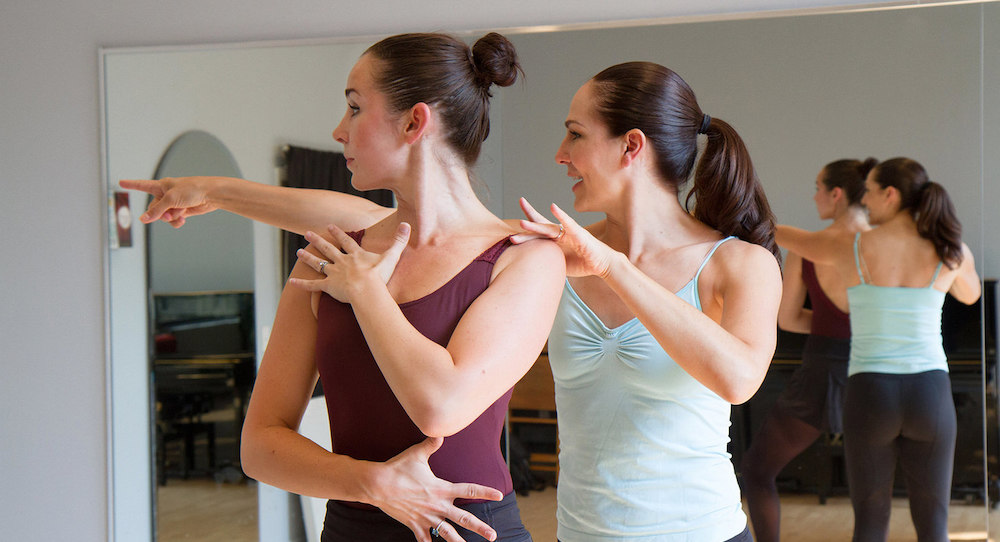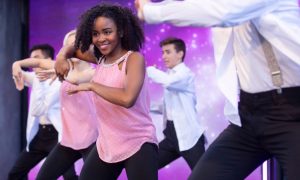She’s one of the most sought-after professional dance coaches in New York City. If you haven’t (yet) heard of her, you’ve probably seen her former students in action. Rhonda Malkin trains aspiring professional dancers — and she’s really, really good at it. Malkin’s former students can be seen performing on Broadway, in national tours, for NBA and NFL dance teams, on cruise ships, and for Disney Theme Parks around the world. Oh, and she’s also had 37 of her dancers book the Radio City Rockettes. “That’s an entire line of Rockettes,” Malkin jokes, “plus a swing!”
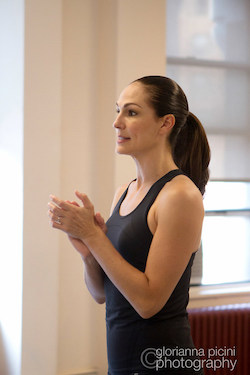
Rhonda Malkin. Photo by Glorianna Picini.
What does it mean to be a professional dance coach? And why does a dancer need one? Dance Informa spoke with Malkin — between a jam-packed day of private lessons — to get a better understanding of her job and obvious magic touch when it comes to churning out the most marketable dancers in the business.
Malkin grew up a competition kid in Southern California. Starting at age 15, she began teaching dance at her local studio to help subsidize the cost of her own many classes. After graduating high school, Malkin attended UCLA and started off as a proposed dance major. She soon realized, however, that she didn’t need a degree in dance to be a dancer. Instead, she signed with an esteemed Hollywood agency and began working professionally in Los Angeles, in TV, film, commercials and as an NBA Laker Girl, all while getting her bachelor’s degree in Sociology.
One of Malkin’s most memorable Hollywood auditions was for the Radio City Rockettes. “I was amazed at how precise the choreography was,” she recalls. “I didn’t book the job. I knew my kicks weren’t quite right. So, I worked on them and booked it the next time!” Post-UCLA, Malkin’s dancing aspirations eventually brought her across the country to New York City. She danced with the Radio City Rockettes for a remarkable 12 seasons.
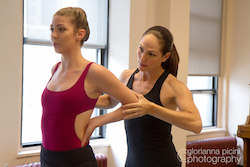
Rhonda Malkin. Photo by Glorianna Picini.
After over 25 years of dancing professionally, Malkin may be “retired” from the stage, but the mother of three is certainly not slowing down. “I feel joy from seeing my students achieve their dreams,” she says. In addition to her full-time job as a mother, Malkin rocks a packed schedule of private lessons and professional workshops for female dancers ages 17 and up.
So, what exactly is professional dance coaching? “I teach it all — from soup to nuts!” Malkin jests. “It’s the stuff you might not receive in a typical dance class or training program. Everything from performance quality, strength-training, headshot and resume assistance, body awareness, and precision dance technique.” Each dancer expresses her goals and aspirations to Malkin at the start of their training. Then, it’s straight to work. Malkin utilizes her experience as a dancer, teacher and personal trainer to coach each individual dancer on her journey to a professional career.
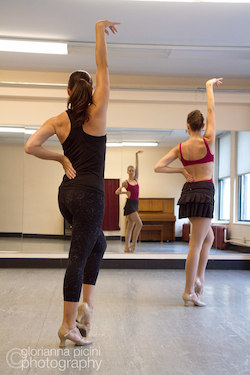
Rhonda Malkin. Photo by Glorianna Picini.
“If you want to book a job on Broadway, with the Rockettes or on an NBA dance team, you have to be the best possible dancer,” says Malkin. “Besides flawless technique, you need to pick up choreography quickly, know how to dance in high heels, have a strong and able body, present a professional attitude, and exude confidence.”
Malkin uses her own choreography — which she bases upon a dancer’s specific dream job (i.e. precision jazz and tap for an aspiring Rockette, cheer-based routines for a Knicks City Dancers hopeful) — as the medium to coach her dancers.
“I’m honest,” Malkin notes, “with both my students and their parents.” While many studios might simply encourage families to spend more money on their dancers through classes and competitions, Malkin serves it straight. “If a dancer has a dream that doesn’t align with the training she’s had, I’ll tell her that, and I’ll also explain how we’re going to work together to get there.” It might take a lot of time and hard work, but nothing worth having comes easy.
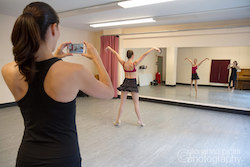
Rhonda Malkin. Photo by Glorianna Picini.
Another part of Malkin’s work is breaking dancers’ bad habits. “It’s not a dancer’s fault,” she explains, “but often, a dancer will have bad habits ingrained in her. Sometimes it can take years to break them!”
The top three bad habits that Malkin notices amongst this generation of dancers are 1) sitting their weight back when dancing in high heels, 2) utilizing the mirror casually rather than as a training tool, and 3) not fully rehabilitating one’s body post-injury.
Malkin is based in New York City and, despite her in-demand schedule, is always looking to train new students in private lessons and professional workshops. She plans to host an upcoming workshop for younger dancers ages 10-16, and eventually to expand her workshops to focus on specific dance jobs such as Broadway, the Rockettes and NBA dance teams.
To learn more about Malkin’s professional dance coaching and to sign-up for an upcoming workshop or even a private lesson or two when you’re visiting New York next summer, visit www.fusionexercise.com.
By Mary Callahan of Dance Informa.


